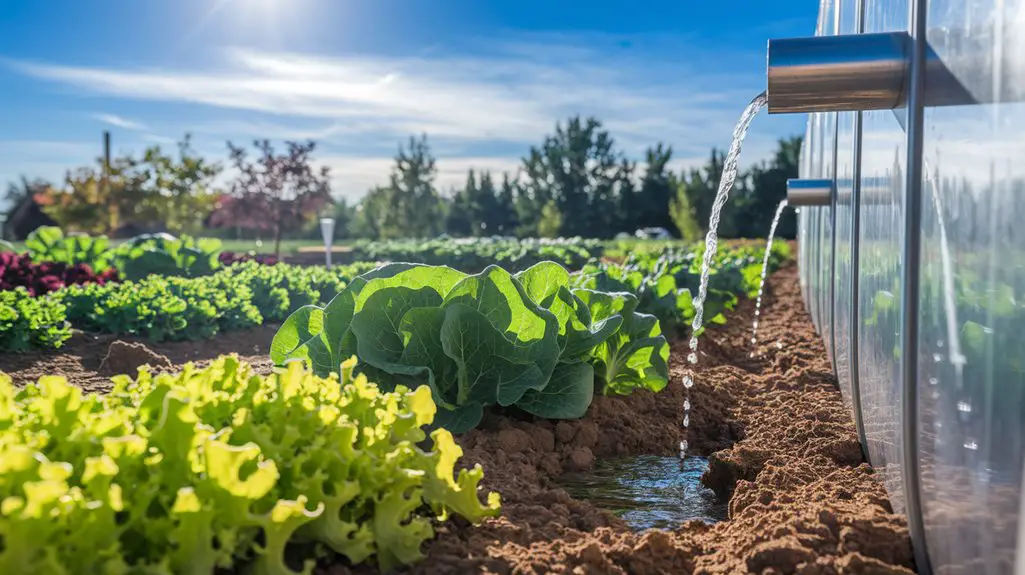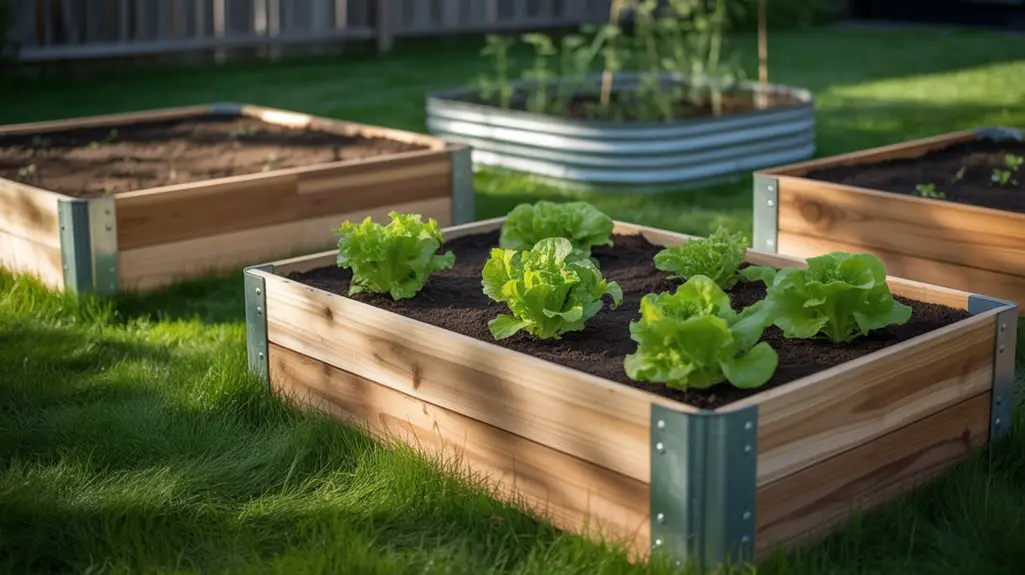You’re missing out on garden potential if you’re not capturing free, chemical-free water from the sky. Rainwater harvesting transforms your vegetable garden’s productivity while reducing your environmental footprint and water bills. With pH levels that naturally promote nutrient absorption, rainwater gives your plants distinct advantages over treated municipal water. A properly designed system requires minimal investment but delivers maximum returns—and the methods are simpler than you might think.
Why Rainwater Is Ideal for Vegetable Gardens
Although municipal water keeps your garden alive, rainwater offers distinct advantages that can transform your vegetable garden from surviving to thriving.
Unlike treated tap water, rainwater contains no chlorine, fluoride, or other chemicals that can accumulate in soil and stress plants over time.
Rainwater’s slightly acidic pH (typically 5.6-6.0) helps release essential nutrients in soil that might otherwise remain bound and unavailable to your vegetables.
It’s naturally soft, containing trace minerals like nitrogen that act as a mild fertilizer.
Temperature matters too—rainwater matches ambient air temperature, preventing the root shock that cold tap water often causes.
For water-sensitive crops like tomatoes, peppers, and leafy greens, this natural irrigation source can greatly improve yields and flavor profiles. Additionally, implementing sustainable rainwater harvesting practices ensures a consistent and eco-friendly water supply for your garden.
Essential Components of a Garden Rainwater System

While designing your rainwater harvesting system, you’ll need to understand the essential components that form a complete and efficient setup.
The foundation is a quality catchment surface—typically your roof—connected to properly sized gutters and downspouts that direct water flow.
You’ll require a first-flush diverter to eliminate initial runoff containing debris and contaminants, followed by a filter system to remove remaining particles.
Storage is critical—tanks or barrels must be opaque to prevent algae growth, screened to block insects, and sized according to your garden’s needs and local rainfall patterns.
Don’t overlook a reliable distribution method, which might include gravity-fed hoses, drip irrigation, or pumps depending on your garden layout.
Finally, install an overflow mechanism to manage excess water during heavy rainfall events.
Calculating Your Garden’s Water Needs

Calculating Your Garden’s Water Needs
Understanding your garden’s precise water requirements forms the foundation of an efficient rainwater harvesting system.
Calculate your needs by multiplying your garden’s square footage by 0.5 gallons per square foot weekly during moderate weather, and 1 gallon during hot periods.
Factor in plant-specific demands—leafy greens require about 1 inch of water weekly, while fruiting plants like tomatoes need 1-2 inches.
Clay soils retain moisture longer than sandy ones, affecting your watering schedule.
Don’t forget to account for seasonal variations. You’ll need 30-50% more water during summer months than in spring or fall.
Track rainfall amounts with a simple rain gauge to determine supplemental irrigation needs and adjust your collection capacity accordingly. Additionally, incorporating rainwater harvesting systems can significantly enhance your garden’s sustainability and efficiency.
DIY Rain Barrel Installation Guide
Once you’ve calculated your garden’s water requirements, setting up a DIY rain barrel collection system offers an economical and sustainable solution for irrigation.
Begin by selecting a food-grade barrel with a capacity of 50-80 gallons and position it beneath a downspout on level ground.
Drill a hole near the bottom for your spigot installation, applying waterproof sealant around the fixture. Add a second hole 2-3 inches from the top as an overflow outlet.
Cut an opening in the lid and cover it with fine mesh screening to filter debris and prevent mosquito breeding.
Connect your downspout to the barrel’s intake using flexible downspout extensions or a rain chain.
For maximum pressure, elevate your barrel on concrete blocks, allowing gravity to drive water flow to your garden. Additionally, consider incorporating compact rainwater systems to optimize space and efficiency in your backyard setup.
Beyond Barrels: Advanced Collection Methods
Although rain barrels provide an excellent starting point for water conservation, serious gardeners can implement several more sophisticated collection methods for maximum efficiency. Consider upgrading to an integrated system that matches your garden’s scale and your regional rainfall patterns.
| Collection Method | Capacity Range | Best For |
|---|---|---|
| Dry Systems | 200-500 gallons | Small gardens, periodic use |
| Wet Systems | 500-1500 gallons | Mid-sized plots, regular irrigation |
| Cisterns | 1500+ gallons | Large gardens, drought resilience |
Underground tanks conserve space while protecting water from algae growth and temperature fluctuations. Gravity-fed drip irrigation systems can be connected to your collection system, allowing for automated watering cycles that deliver moisture directly to root zones. For substantial properties, consider designing swales and berms to passively direct rainwater to garden areas. Additionally, implementing effective rainwater filtration techniques will ensure the collected water is clean and safe for your plants.
Filtering and Treating Harvested Rainwater
While rainwater is naturally soft and free from many of the chemicals found in municipal supplies, it requires proper filtration and treatment before use on edible plants.
Start with a first-flush diverter to redirect initial runoff containing roof debris, bird droppings, and airborne pollutants.
Install a multi-stage filtration system: begin with mesh screens (500-1000 microns) to catch large debris, followed by finer filters (20-50 microns) for smaller particles.
For food garden applications, consider UV sterilization or food-grade hydrogen peroxide (1 tablespoon per gallon) to eliminate harmful microorganisms.
Test your rainwater pH regularly—vegetable gardens typically require 6.0-7.0.
If necessary, adjust with small amounts of agricultural lime to raise pH or food-grade citric acid to lower it. Additionally, incorporating innovative rainwater systems can enhance the efficiency of your harvesting efforts.
Creating a Gravity-Fed Irrigation Network
A gravity-fed irrigation network forms the backbone of any efficient water conservation system in your vegetable garden.
Position your rain barrels or cisterns at elevated points to create natural water pressure without pumps. Connect the main storage container to a header pipe with multiple outlet valves using food-grade PVC or polyethylene tubing.
Install a primary filter at the tank outlet to prevent clogging, then run distribution lines to different garden zones.
You’ll need pressure-compensating drip emitters (1-2 gallons per hour) for consistent flow regardless of elevation changes. Incorporate adjustable micro-sprinklers for seedlings and shallow-rooted plants.
Add timers and manual shut-off valves at key junction points for controlled watering.
Verify all connections are secure and test the system at low pressure before full implementation to identify potential leaks. Rainwater systems can significantly reduce water bills and promote sustainable gardening practices.
Seasonal Maintenance of Your Harvesting System
Just as your irrigation system requires maintenance, your harvesting tools and equipment need regular seasonal attention to perform at their best.
Clean and sharpen pruners, shears, and knives after each use to prevent disease transmission and guarantee clean cuts.
In spring, inspect all harvesting baskets and containers for mold or damage. Sanitize them with a 10% bleach solution.
Check your gravity-fed system for clogs and clean filters before peak growing season. Regular maintenance ensures that your rainwater collection barrels operate efficiently.
Summer maintenance includes lubricating moving parts on wheelbarrows and carts.
Keep shade cloths handy to protect harvested produce from sun damage.
During fall, thoroughly clean all harvesting tools before storage.
Drain and store collection barrels to prevent freezing damage in winter.
Apply food-grade mineral oil to wooden handles to prevent cracking and extend tool life.
Cost-Benefit Analysis of Rainwater Gardening
Because rainwater collection systems require initial investment, conducting a thorough cost-benefit analysis will help you determine if rainwater gardening makes financial sense for your situation.
Calculate your current water costs for gardening over a typical season, then compare this to the setup expenses of a rainwater system (barrels, gutters, filters, pumps).
Most gardeners recoup their investment within 2-3 growing seasons, depending on local rainfall patterns and water pricing.
Don’t overlook additional benefits: reduced municipal water usage during restrictions, decreased runoff erosion, and improved plant health from chemical-free water.
The ROI increases considerably in areas with high water prices or frequent droughts.
Track your system’s collection efficiency by measuring rainfall against captured volume—aim for 80% or higher to maximize your return. Additionally, implementing rainwater collection techniques can enhance the overall efficiency of your system and further increase your savings.
Conclusion
Like the mighty oak that stores nutrients for seasons of growth, you’ve now equipped your garden with liquid abundance. You’re no longer a servant to water bills or drought conditions. You’ve built a system that mimics nature’s efficiency, transforming your garden into a self-sustaining ecosystem. Maintain it diligently, and you’ll harvest not just vegetables but the satisfaction of resilience in an increasingly water-conscious world.




